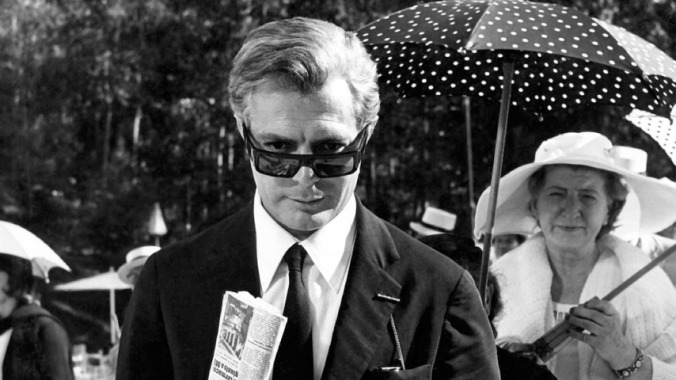Film School: Marcello Mastroianni and Federico Fellini
Subscriber Exclusive

Welcome to Film School! This is a column focused on movie history and all the stars, filmmakers, events, laws and, yes, movies that helped write it. Film School is a place to learn—no homework required.
The most famous scene in Marcello Mastroianni’s mammoth filmography almost didn’t happen. If mega-producer Dino De Laurentiis had had his way, it would have been Paul Newman frolicking with Anita Ekberg in the Trevi Fountain. De Laurentiis thought Mastroianni was “too soft and goody-goody; a family man rather than someone who pushes women into bed.”
But La Dolce Vita director Federico Fellini insisted on Mastroianni, because, as he said to the actor himself (!), he wanted “a very normal face, a face with no personality, a face with no expression, a banal face – a face like yours.” Understandably wounded, Mastroianni nevertheless asked to look at a script, and was instead furnished with, as he stated in an interview with Gideon Bachmann, “…sketches of the sea, with enormous mermaids at the bottom, and on the surface, men floating with big long dongs reaching down to the sea bed.”
Somehow, he still agreed to sign on, and cinema history was made.
Unsurprisingly considering the way Fellini sold it to his lead actor, there was no neat narrative to La Dolce Vita. Mastroianni plays Marcello, a journalist for a sleazy Roman tabloid who once had far grander ambitions. Those days are far behind him now, and over the course of the movie’s three spectacular, sad hours, we watch him sink irretrievably into the moral abyss.
Mastroianni is exquisite in the role of a lifetime, giving the decay of his character’s soul a quiet, tragic weight amid the hedonistic howl of his lifestyle. “They’re not born cowards, nor without courage.” Mastroianni would say of his wayward characters in a 1987 interview with Curtis Bill Pepper, “They just get lost. They don’t know where to go. There’s no sign or moral truth to live by.” Throughout the movie, we watch as Marcello tries, fruitlessly, to find something to believe in. As he grows ever more jaded, Mastroianni seems to physically change, with the dead-eyed playboy of the final scene seeming a million miles from the earnestly besotted romantic who embraced Ekberg in the Trevi Fountain two hours earlier.
La Dolce Vita was an enormous hit both domestically and globally, collecting impressive box office receipts, winning awards at most major film festivals and the Oscars, and even introducing a new word—“paparazzo”—to the lexicon. Though specifically about the high life/seedy underbelly of Rome, the scathing commentary on the emerging tabloid culture and appearances of stars like Anita Ekberg and former Tarzan actor Lex Barker gave it enormous international appeal. Suddenly, Fellini and Mastroianni were famous all over the world.
Still, they remained at home. “I have nothing against Hollywood. But today’s best films are being made in Italy. So why should I leave Rome?” Mastroianni wondered in 1961. He underlined his point with eight movies released in the three years between his first two collaborations with Fellini, among them, classic existential dramas like La Notte and The Stranger; Divorce Italian Style, which netted him his first Oscar nod; and Hungry for Love, a moving work of social realism in which he co-starred alongside Simone Signoret and Emmanuelle Riva.
Fellini, on the other hand, was significantly less productive, only turning in one segment of anthology film Boccaccio ’70 during that same time period. Fittingly, for a filmmaker whose work was often autobiographical, the production that would reunite the director with his newly found muse was—textually and subtextually—about Fellini having no idea how to follow up on the massive success of La Dolce Vita.
In 8 ½ , Mastroianni plays Guido (but really, Fellini himself), a film director who holes up at a health resort in an attempt to escape the stresses of pre-production and creative block. He soon finds out, however, that there is no escape, and is followed everywhere he goes by a stream of actors and producers and various technicians, all wanting answers he’s in no state to give—and that’s all before you get to his love life, a mess of his own making. As he attempts to pick through the chaos of his life and his film, he retreats into the past, and dreamy fantasies.
While they are different tonally—La Dolce Vita is bleak hedonism; 8 ½ is chaotic hope—Mastroianni serves the same functions in the first two films he made with Fellini. Both feature a lot of people, and yet Mastroianni is so often found on the outside of the group—literally in La Dolce Vita, where he’s far smoother at finding information than his ravenous pack of colleagues; figuratively in 8 ½, where, though everyone wants something from him, he’s still operating on his own plane. He’s a lonely presence, in a busy world.
-

-

-

-

-

-

-

-

-

-

-

-

-

-

-

-

-

-

-

-

-

-

-

-

-

-

-

-

-

-

-

-

-

-

-

-

-

-

-

-








































